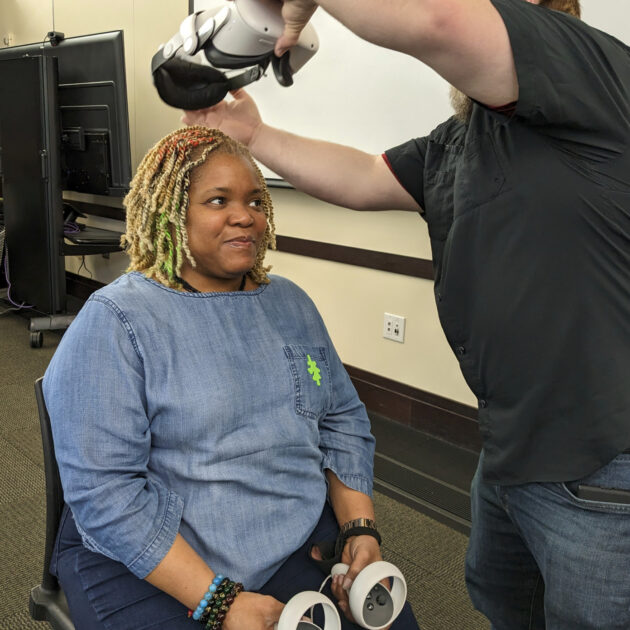
The recognizable chords from Jimi Hendrix’s “Purple Haze” are the sonic greeting to a new virtual reality experience created by digital storyteller Yolanda Barton. Users are transported into a re-creation of Seattle’s Central District, a neighborhood that has been a historic hub for Black artists, businesses and families.
A Seattle native and University of Washington graduate, Barton envisioned the VR experience as a way to capture and share the area’s rich history while also showcasing current leaders in the community. And it serves an additional purpose, connecting the community — including racially, ethnically and socioeconomically diverse users of all ages — with new technology.
“You can experience what was, what is, and what will be the future.”
Barton recently demoed her VR project at the public library’s Douglass-Truth Branch, located in the Central District. Only one or two of the roughly three dozen participants had ever tried VR, she said.
Inside her VR experience, users wandered the Central District’s main streets, visiting recreated facades of vanished sites such as the long-time jazz hot spot the Black and Tan Club, as well as present-day Edwin Pratt Park, named for a local civil rights leader who was assassinated in 1969. The VR weaves together digital illustrations, historic photos and recent video interviews, with a narrator providing details.
After donning Oculus headsets and taking a tour, participants provided enthusiastic feedback.
The VR journey was “amazing” and “incredible,” said Chloe Fulton, a Central District resident and small business owner. “You can experience what was, what is, and what will be the future.”
Here’s a clip of video from Barton’s Central District VR experience showing some beloved local businesses:
Barton began the project seven years ago while working on a UW master’s degree in communications in digital media. The idea for it was sparked by her concerns about how rapidly the area was gentrifying — or “paving over,” as Barton describes it. Data support that impression: from 2010 to 2020, roughly 20% of the Black residents in the zip code that covers the Central District left the area, according to the Seattle Times.
“What do you do about the people who are living there and don’t know the history?” Barton said. “They need to know it.”
The VR experience highlights superstar artists such as jazz legend Ernestine Anderson; rapper Sir Mix-a-Lot; multiple Grammy winner Quincy Jones; and, of course, guitar virtuoso Hendrix. It also features present-day interviews with mixed-media artist Melvin Freeman, also known as the Fly Blind Guy; a venture promoting Black-owned entrepreneurs called Black Dot; and Delbert Richardson, founder of the American History Traveling Museum.

Tana Yasu, who works with Seattle’s Office for Civil Rights, participated in the demo and praised the effort.
“We’re fully capable of telling our own narratives and our own lived experiences,” Yasu said. “And to combine that with technology to bring the youth into it, that opens up a whole new economic playing field for our young people.”
Barton conducted the historical research and interviews for the project, but is not herself a VR developer. She participated in Meta’s Oculus Launch Pad program and received engineering assistance to help create an initial prototype. She has bootstrapped the effort, raising money through speaking engagements, pitch competitions and with support from friends and family.
The entrepreneur recently launched a business called Revere XR to further the effort. She has a 6-person team with skills including videography, animation, programming and technical artistry. Many have donated their time or offered their services for a lower rate.
Barton is an evangelist for the potential uses of VR and AR, or augmented reality, beyond the sector’s focus primarily on gaming to date.
She has ideas for applications in education and tourism promotions. She wants to create an XR or “extended reality” marketplace to help small businesses provide a more engaged shopping experience for customers online. She would love to partner with a museum — maybe Seattle’s MOHAI or MoPOP — to develop a more immersive experiences for visitors.
“I’m creating the Marvel Team for AR and VR,” Barton said. “We’re going to show people what we can do that amplifies arts and culture.“



